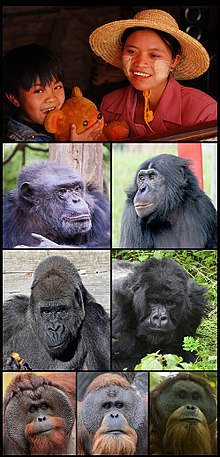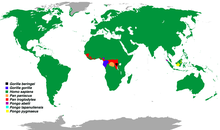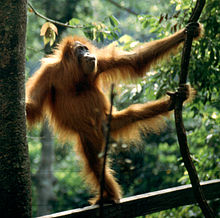
A | B | C | D | E | F | G | H | CH | I | J | K | L | M | N | O | P | Q | R | S | T | U | V | W | X | Y | Z | 0 | 1 | 2 | 3 | 4 | 5 | 6 | 7 | 8 | 9
| Hominidae[1] | |
|---|---|

| |
| The eight extant hominid species, one row per genus (humans, chimpanzees, gorillas, orangutans) | |
| Scientific classification | |
| Domain: | Eukaryota |
| Kingdom: | Animalia |
| Phylum: | Chordata |
| Class: | Mammalia |
| Order: | Primates |
| Suborder: | Haplorhini |
| Infraorder: | Simiiformes |
| Parvorder: | Catarrhini |
| Superfamily: | Hominoidea |
| Family: | Hominidae Gray, 1825[2] |
| Type genus | |
| Homo Linnaeus, 1758
| |
| Subfamilies | |
|
sister: Hylobatidae | |

| |
| Distribution of great ape species | |
| Synonyms | |
| |
The Hominidae (/hɒˈmɪnɪdiː/), whose members are known as the great apes[note 1] or hominids (/ˈhɒmɪnɪdz/), are a taxonomic family of primates that includes eight extant species in four genera: Pongo (the Bornean, Sumatran and Tapanuli orangutan); Gorilla (the eastern and western gorilla); Pan (the chimpanzee and the bonobo); and Homo, of which only modern humans (Homo sapiens) remain.[1]
Numerous revisions in classifying the great apes have caused the use of the term hominid to change over time. The original meaning of "hominid" referred only to humans (Homo) and their closest extinct relatives. However, by the 1990s humans, apes, and their ancestors were considered to be "hominids".
The earlier restrictive meaning has now been largely assumed by the term hominin, which comprises all members of the human clade after the split from the chimpanzees (Pan). The current meaning of "hominid" includes all the great apes including humans. Usage still varies, however, and some scientists and laypersons still use "hominid" in the original restrictive sense; the scholarly literature generally shows the traditional usage until the turn of the 21st century.[5]
Within the taxon Hominidae, a number of extant and extinct genera are grouped with the humans, chimpanzees, and gorillas in the subfamily Homininae; others with orangutans in the subfamily Ponginae (see classification graphic below). The most recent common ancestor of all Hominidae lived roughly 14 million years ago,[6] when the ancestors of the orangutans speciated from the ancestral line of the other three genera.[7] Those ancestors of the family Hominidae had already speciated from the family Hylobatidae (the gibbons), perhaps 15 to 20 million years ago.[7][8]
Due to the close genetic relationship between humans and the other great apes, certain animal rights organizations, such as the Great Ape Project, argue that nonhuman great apes are persons and should be given basic human rights. Twenty-nine countries have instituted research bans to protect great apes from any kind of scientific testing.[9]
Evolution

In the early Miocene, about 22 million years ago, there were many species of tree-adapted primitive catarrhines from East Africa; the variety suggests a long history of prior diversification. Fossils from 20 million years ago include fragments attributed to Victoriapithecus, the earliest Old World monkey. Among the genera thought to be in the ape lineage leading up to 13 million years ago are Proconsul, Rangwapithecus, Dendropithecus, Limnopithecus, Nacholapithecus, Equatorius, Nyanzapithecus, Afropithecus, Heliopithecus, and Kenyapithecus, all from East Africa.
At sites far distant from East Africa, the presence of other generalized non-cercopithecids, that is, non-monkey primates, of middle Miocene age—Otavipithecus from cave deposits in Namibia, and Pierolapithecus and Dryopithecus from France, Spain and Austria—is further evidence of a wide diversity of ancestral ape forms across Africa and the Mediterranean basin during the relatively warm and equable climatic regimes of the early and middle Miocene. The most recent of these far-flung Miocene apes (hominoids) is Oreopithecus, from the fossil-rich coal beds in northern Italy and dated to 9 million years ago.
Molecular evidence indicates that the lineage of gibbons (family Hylobatidae), the "lesser apes", diverged from that of the great apes some 18–12 million years ago, and that of orangutans (subfamily Ponginae) diverged from the other great apes at about 12 million years. There are no fossils that clearly document the ancestry of gibbons, which may have originated in a still-unknown South East Asian hominoid population; but fossil proto-orangutans, dated to around 10 million years ago, may be represented by Sivapithecus from India and Griphopithecus from Turkey.[10] Species close to the last common ancestor of gorillas, chimpanzees and humans may be represented by Nakalipithecus fossils found in Kenya and Ouranopithecus fossils found in Greece. Molecular evidence suggests that between 8 and 4 million years ago, first the gorillas (genus Gorilla), and then the chimpanzees (genus Pan) split off from the line leading to humans. Human DNA is approximately 98.4% identical to that of chimpanzees when comparing single nucleotide polymorphisms (see human evolutionary genetics).[11] The fossil record, however, of gorillas and chimpanzees is limited; both poor preservation—rain forest soils tend to be acidic and dissolve bone—and sampling bias probably contribute most to this problem.
Other hominins probably adapted to the drier environments outside the African equatorial belt; and there they encountered antelope, hyenas, elephants and other forms becoming adapted to surviving in the East African savannas, particularly the regions of the Sahel and the Serengeti. The wet equatorial belt contracted after about 8 million years ago, and there is very little fossil evidence for the divergence of the hominin lineage from that of gorillas and chimpanzees—which split was thought to have occurred around that time. The earliest fossils argued by some to belong to the human lineage are Sahelanthropus tchadensis (7 Ma) and Orrorin tugenensis (6 Ma), followed by Ardipithecus (5.5–4.4 Ma), with species Ar. kadabba and Ar. ramidus.
Taxonomy
Terminology

The classification of the great apes has been revised several times in the last few decades; these revisions have led to a varied use of the word "hominid" over time. The original meaning of the term referred to only humans and their closest relatives—what is now the modern meaning of the term "hominin". The meaning of the taxon Hominidae changed gradually, leading to a modern usage of "hominid" that includes all the great apes including humans.
A number of very similar words apply to related classifications:
- A hominoid, sometimes called an ape, is a member of the superfamily Hominoidea: extant members are the gibbons (lesser apes, family Hylobatidae) and the hominids.
- A hominid is a member of the family Hominidae, the great apes: orangutans, gorillas, chimpanzees and humans.
- A hominine is a member of the subfamily Homininae: gorillas, chimpanzees, and humans (excludes orangutans).
- A hominin is a member of the tribe Hominini: chimpanzees and humans.[12]
- A homininan, following a suggestion by Wood and Richmond (2000), would be a member of the subtribe Hominina of the tribe Hominini: that is, modern humans and their closest relatives, including Australopithecina, but excluding chimpanzees.[13][14]
- A human is a member of the genus Homo, of which Homo sapiens is the only extant species, and within that Homo sapiens sapiens is the only surviving subspecies.
A cladogram indicating common names (cf. more detailed cladogram below):
| Hominoidea | |
| hominoids, apes |
Extant and fossil relatives of humans

Hominidae was originally the name given to the family of humans and their (extinct) close relatives, with the other great apes (that is, the orangutans, gorillas and chimpanzees) all being placed in a separate family, the Pongidae. However, that definition eventually made Pongidae paraphyletic because at least one great ape species (the chimpanzees) proved to be more closely related to humans than to other great apes. Most taxonomists today encourage monophyletic groups—this would require, in this case, the use of Pongidae to be restricted to just one closely related grouping. Thus, many biologists now assign Pongo (as the subfamily Ponginae) to the family Hominidae. The taxonomy shown here follows the monophyletic groupings according to the modern understanding of human and great ape relationships.
Humans and close relatives including the tribes Hominini and Gorillini form the subfamily Homininae (see classification graphic below). (A few researchers go so far as to refer the chimpanzees and the gorillas to the genus Homo along with humans.)[15][16][17] But, those fossil relatives more closely related to humans than the chimpanzees represent the especially close members of the human family, and without necessarily assigning subfamily or tribal categories.[18]
Many extinct hominids have been studied to help understand the relationship between modern humans and the other extant hominids. Some of the extinct members of this family include Gigantopithecus, Orrorin, Ardipithecus, Kenyanthropus, and the australopithecines Australopithecus and Paranthropus.[19]
The exact criteria for membership in the tribe Hominini under the current understanding of human origins are not clear, but the taxon generally includes those species that share more than 97% of their DNA with the modern human genome, and exhibit a capacity for language or for simple cultures beyond their 'local family' or band. The theory of mind concept—including such faculties as empathy, attribution of mental state, and even empathetic deception—is a controversial criterion; it distinguishes the adult human alone among the hominids. Humans acquire this capacity after about four years of age, whereas it has not been proven (nor has it been disproven) that gorillas or chimpanzees ever develop a theory of mind.[20] This is also the case for some New World monkeys outside the family of great apes, as, for example, the capuchin monkeys.
However, even without the ability to test whether early members of the Hominini (such as Homo erectus, Homo neanderthalensis, or even the australopithecines) had a theory of mind, it is difficult to ignore similarities seen in their living cousins. Orangutans have shown the development of culture comparable to that of chimpanzees,[21] and some[who?] say the orangutan may also satisfy those criteria for the theory of mind concept. These scientific debates take on political significance for advocates of great ape personhood.
Phylogeny
This section needs additional citations for verification. (July 2019) |
Below is a cladogram with extinct species.[22][23][24][failed verification] It is indicated approximately how many million years ago (Mya) the clades diverged into newer clades.[25]
